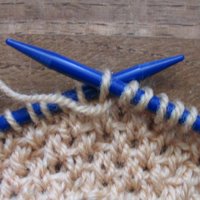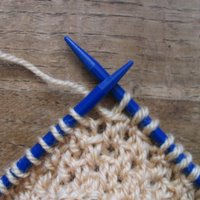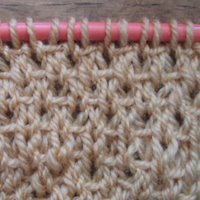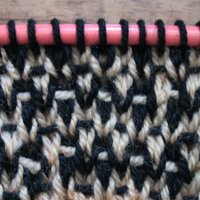
Recently Linda wrote to Ask the Guru:
"I am trying to find instructions for a "half linen stitch". Have you heard of it?"
The KnittingGuru answers:
I am familiar with this stitch. It isn't always called Half-Linen Stitch, however. Barbara Walker calls it Woven Stitch, for example. Most knitting stitches have numerous names and sometimes this causes problems when we try to research them.
One thing that's important to be aware of is that this is a very dense stitch. It belongs to the category of stitches called Slip Stitch and as such it involves slipping certain stitches over two (or more) rows. This is sometimes called Mosaic Knitting and it's an interesting technique in that you can knit fabrics that have patterns without using two or more colors in the same row. You are always knitting with only one yarn at a time for the whole row. The slipped stitch can be made with the yarn in front of the work or behind it. This gives two very different textures.
I knit the samples using sport weight wool (DK weight) with size 8 needles and then with size 10 needles. If you were knitting stockinette, you would probably use size 4 or 5 needles with this yarn. With Half-Linen Stitch, the size 8 needles yielded an extremely thick fabric with no drape. Even with size 10 needles the fabric is quite thick. You will also find that compared to stockinette, all slip stitch patterns have a gauge with many more rows per inch and often with many more stitches to achieve the same width. Be on guard about this! You cannot substitute slip stitch for plain knitting in a pattern or you will end up with a VERY SHORT garment and maybe a very narrow garment, too!
This is how the Half-Linen Stitch is knit:
Cast on an odd number of stitches.
Row 1 - Knit 1, *slip 1 stitch with yarn in front, knit 1* repear from * to * to end.
Row 2 - Purl.
Row 3 - Knit 2, *slip 1 stitch with yarn in front, knit 1* repear from * to * to end.
Row 4 - Purl.
Here are photos of the Half-Linen Stitch shown on both sizes 8 and 10 needles. I have also shown the "slip with yarn in front" component of the stitch. By the way, this is a very simple stitch to knit.

This photo shows the yarn in front of the slipped stitch.

Now the yarn is placed behind the needle in preparation for knitting one stitch.

This photo shows the Half-Linen Stitch done on size 8 needles with sport weight yarn. It would be suitable for a very heavy and warm winter jacket with no drape.

This is the same stitch and yarn knit on size 10 needles. It is still thick, but has a softer, more open texture. It would be suitable for a warm sweater.

This is the Half-Linen Stitch knit on size 10 needles with two colors. Rows 1 & 2 are knit in light gold and Rows 3 & 4 are knit in black. Doesn't this make a great tweed? Can't you see this as a fabulous fall jacket?

Here's my swatch with one of my KnittingGuru Swatch Cards attached for my records. I know never to trust to my memory about these statistics and so I always use a card. You can buy these in the KnittingGuru Boutique.
I hope that Linda and the rest of my readers found this discussion to be clear and helpful, and that you'll try this stitch next time you want something really warm to wear or use as a blanket.
For other interesting Knitting Articles please check out KnittingGuru. I am always happy to answer your questions at Ask the Guru.

8 comments:
Thank you for posting this - I always like learning alternate names for the same stitch pattern. Would this lie flat enough for a blanket edge or does it tend to curl? It looks like it would make a very nice edging around a basic blanket.
Hi Carol,
I'm glad you liked this tutorial post. You can see more on my website -- www.knittingguru.com.
I knit the samples to answer Linda's question and photographed them while the stitch was still on my needles. The fabric does lie flat and would be flatter still after a little steam blocking. I think this would make a nice tailored blanket edge. Just remember, if the blanket itself is in another stitch such as stockinette, you do need to knit the edge in half-linen stitch separately since it requires many more rows per inch than most other stitches and would cause puckering if you tried to knit it along with another stitch. So... just knit a narrow band and overcast it to the blanket. Using a contrasting color for the overcast might add a nice design element.
Good luck with your blanket!
I do the linen stitch a lot. It seems to work better if you go two sizes up in your needles. So if the yarn would normally take a 6 US, try an 8 US. I also give the fabric a snap as I go along as this seem to help set the stitch. It's fabulous for multi colors of variegated yarns -- try changing every four rows. The slip stitches are then pulled up into the next rows and you get something that looks like an Impressionist painting.
It's true that the stitch is very nice. I actually liked it when I used the size 10 needle which was 4 sizes up from what you would expect with sport yarn.
I find slip stitches to be very versatile as long as you understand their tendency to pull in and are willing to use a little more yarn than you might expect.
That's an excellent explanation. At first, while reading and seeing the off-white photos, I was thinking you needed to show the bi-color, then, there it was!
I use the linen stitch frequently - that's the one where you also do the same on the purl side. That makes for an even sturdier fabric.
Glad you liked the explanation, Susan.
I'm afraid that making linen stitch even sturdier would be too unyielding for my taste, though. Unless you were knitting a rug, perhaps.
I personally like my knits to drape and so I have loosened up on my gauge over the years. I know it's a matter of taste, but having developed Carpal Tunnel Syndrome in both wrists also led me to loosen up and I've been glad ever since.
Thank you so much for the illustrations. It is much easier for me to see pictures than watch a video.
Shirley.
I'm impressed by how this dense technique creates interesting patterns without using multiple colors.
Post a Comment